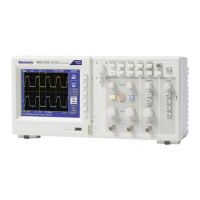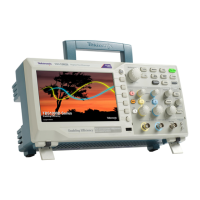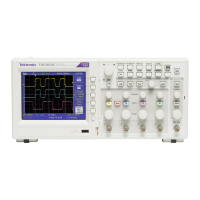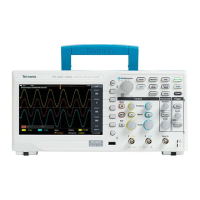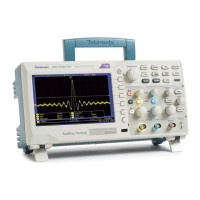Scaling and positioning waveforms
You can change the display of waveforms by adjusting the scale and position.
When you change the scale, the waveform display will increase or decrease in
size. When you change the position, the waveform will move up, down, right, or
left.
The channel indicator (located on the left of the graticule) identifies each
waveform on the display. The indicator points to the ground reference level of the
waveform record.
You can view the display area and readouts. See Display area on page 10.
Vertical scale and position
You can change the vertical position of waveforms by moving them up or down
in the display. To compare data, you can align a waveform above another or you
can align waveforms on top of each other.
You can change the vertical scale of a waveform. The waveform display will
contract or expand relative to the ground reference level.
For oscilloscope-specific descriptions, see Vertical controls on page 12, and also
in the Reference chapter, see Vertical controls on page 111.
Horizontal scale and
position; pretrigger
information
You can adjust the Horizontal Position control to view waveform data before
the trigger, after the trigger, or some of each. When you change the horizontal
position of a waveform, you are actually changing the time between the trigger
and the center of the display. (This appears to move the waveform to the right or
left on the display.)
For example, if you want to find the cause of a glitch in your test circuit, you
might trigger on the glitch and make the pretrigger period large enough to capture
data before the glitch. You can then analyze the pretrigger data and perhaps find
the cause of the glitch.
You change the horizontal scale of all the waveforms by turning the Horizontal
Scale knob. For example, you might want to see just one cycle of a waveform to
measure the overshoot on its rising edge.
The oscilloscope shows the horizontal scale as time per division in the scale
readout. Since all active waveforms use the same time base, the oscilloscope only
displays one value for all the active channels, except when you use zoom feature.
For oscilloscope-specific descriptions, see Position on page 22, and also in the
Reference chapter, see Horizontal on page 89.
Time Domain Aliasing. Aliasing occurs when the oscilloscope does not sample
the signal fast enough to construct an accurate waveform record. When this
happens, the oscilloscope displays a waveform with a frequency lower than the
actual input waveform, or triggers and displays an unstable waveform.
Understanding oscilloscope functions
24 TBS1000B and TBS1000B-EDU Series Oscilloscopes User Manual
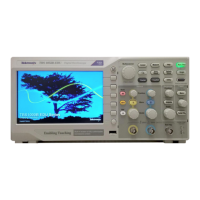
